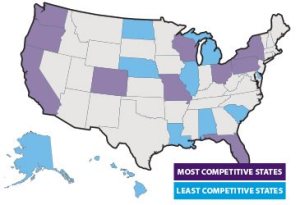Survey results show pathologists and clinical lab managers why largest health insurers have market clout and can exclude local labs from their provider networks
Over the past two decades, ongoing mergers and acquisitions of health insurance organizations have led to ever-greater concentration of market share, even as the number of large health insurance companies has shrunk. One consequence of this trend is that many clinical laboratories and anatomic pathology groups have lost access to managed care patients.
The degree of market concentration will surprise most pathologists and medical laboratory professionals. The concentration of market ownership is clearly demonstrated by the fact that the 25 largest health insurers in the United States now control two-thirds of this $744-billion market. But the largest plans are not necessarily the best, according to 2013 consumer satisfaction surveys conducted by J.D. Power & Associates.
Wellpoint (Anthem Inc.) Controls Top Market Share in 82 Metro Areas
Recently renamed Anthem Inc. (NYSE:AMTM, formerly called Wellpoint) commands the top position in more than one in five U.S. markets. Of 388 metropolitan areas, Anthem has the greatest market share in 82 of them, according to a new study from the American Medical Association (AMA).
From a regional market share perspective, Health Care Service Corp. (HCSC) is second nationally. It has the biggest market share in 37 metropolitan areas. Next is UnitedHealth Group (NYSE:UNH) (UHC) with the top market share in 35 urban markets.
AMA Study Finds Lack of Competition in 72% of Urban Markets
In fact, the AMA study found a significant absence of health insurer competition in 72% of the metropolitan areas studied. These markets are rated “highly concentrated” based on the guidelines used by the U.S. Department of Justice and Federal Trade Commission (FTC). These guidelines are used to assess degree of competition in a given market.

Shown above is a map prepared by the American Medical Association based on its study of competition among health insurers across the regional markets in the United States. (Map copyright American Medical Association)
Additionally, 17 states had a single health insurer with a commercial market share of 50% or more, and 45 states had two health insurers with a combined commercial market share of 50% or more.
“The AMA is greatly concerned that in 41% of metropolitan areas, a single health insurer had at least a 50% share of the commercial health insurance market,” declared AMA President Robert M. Wah, M.D.. “The dominant market power of big health insurers increases the risk of anti-competitive behavior that harms patients and physicians, and presents a significant barrier to the market success of smaller insurance rivals,” he commented.

Commenting on a recent study by the American Medical Association (AMA), AMA President Robert M. Wah, M.D. (pictured above) expressed concern about how lack of competition among health plan providers affects patients and physicians. He noted the study found that a single health insurer has at least 50% of market share in 41 urban markets nationally. (Photo copyright American Medical Association)
J.D. Powers Study Suggests Biggest is Not Necessarily Best
Wah’s comments are not unfounded, as the J.D. Power surveys of consumer satisfaction with their health insurance plans suggested that biggest is not always best.
In California, Oakland-based Kaiser Permanente, the state’s largest health plan with 40% market share, had the highest score with 769 points out of 1,000. But Anthem Blue Cross, the second largest plan by market share, had one of the lowest scores with just 677 points.
Ranking of the top 25 health plans by market share, according to National Association of Insurance Commissioners (NAIC), is as follows.
Rank and Insurer:
- UnitedHealth Group
- Kaiser Foundation Group
- Anthem Inc. (Formerly Wellpoint Inc. Group)
- Aetna Group
- Humana Group
- HCSC Group
- Cigna Health Group
- Highmark Group
- Blue Shield of California Group
- Independence Blue Cross Group
- Centene Corp Group
- HIP Insurance Group
- BCBS of New Jersey Group
- BCBS of Michigan Group
- Guidewell Mutual Holdings Group
- California Physicians’ Service
- Wellcare Group
- Carefirst Inc. Group
- Health Net of California, Inc.
- Molina Healthcare Inc. Group
- UHC of California
- Lifetime Healthcare Group
- BCBS of Massachusetts Group
- Metropolitan Group
- Cambia Health Solutions Inc.
Lack of Competition Among Health Plans Affects Patients and Providers
As pathologists and clinical laboratory managers know, the ongoing consolidation of health plan ownership in many metropolitan areas around the United States has already made it more difficult for local laboratories to retain status as a network lab test provider. If any other trend could offset this market dynamic, it would be the continued growth of accountable care organizations accountable care organizations (ACOs) anchored by a region’s largest hospitals and health systems. Such ACOs tend to include the local clinical labs and pathology groups in their communities as network providers.
—by Patricia Kirk
Related Information:
Survey: Kaiser tops in customer satisfaction for health insurance
AMA Study Finds WellPoint to be the Largest Health Insurer in Many Local Markets



